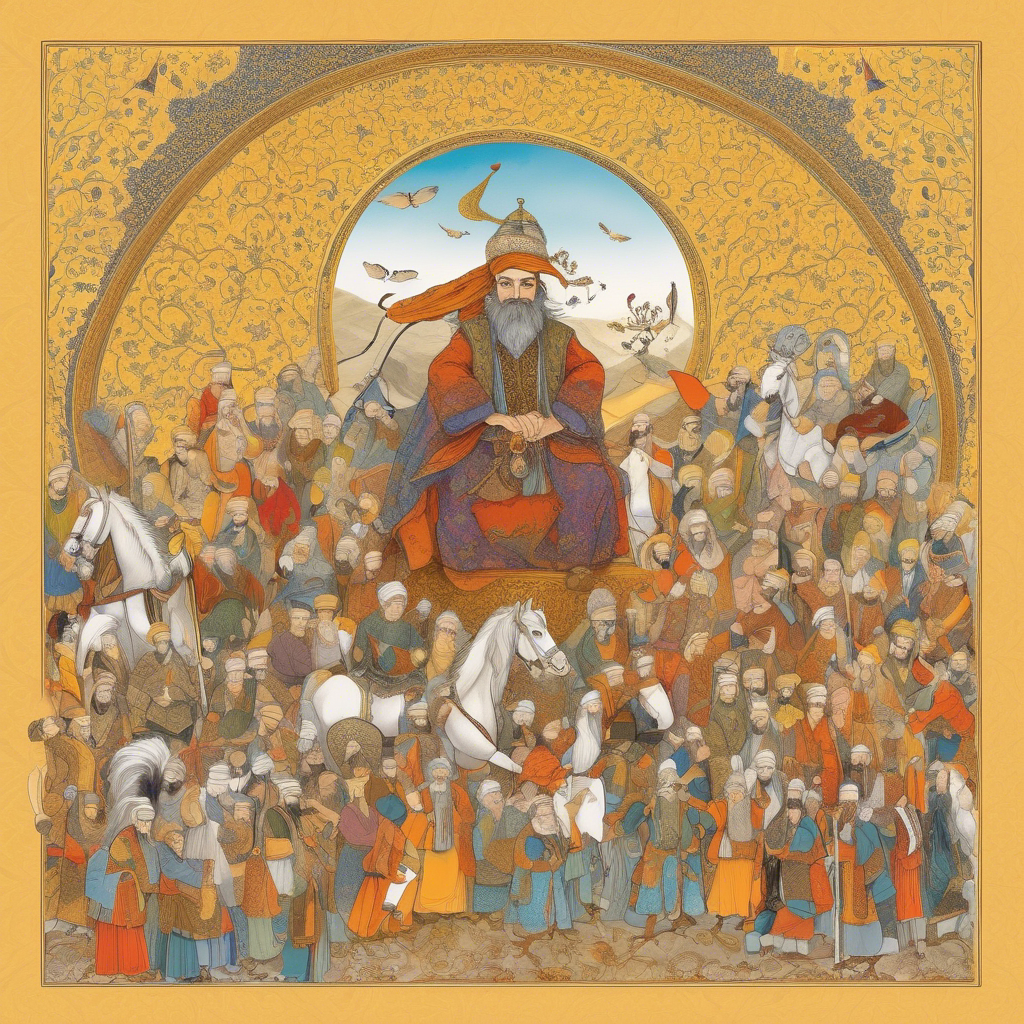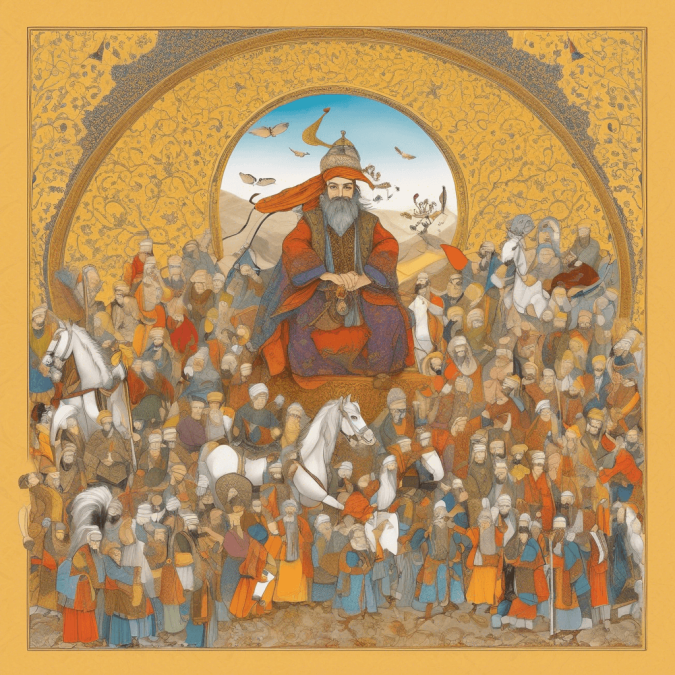
The Shahnameh, also known as the Book of Kings, is an epic poem written by the Persian poet Ferdowsi in the 10th century. It tells the mythical and historical stories of the Persian kings from ancient times to the Islamic conquest of Persia. The Shahnameh is divided into three sections: mythical, heroic, and historical. It celebrates Persian culture, language, and history, and has had a significant influence on Persian literature and identity. The poem covers a wide range of themes including love, war, loyalty, and heroism. It is considered one of the greatest literary works in the Persian language and has been translated into many languages. The Shahnameh remains an important part of Persian cultural heritage and continues to be studied and appreciated worldwide.
The Shahnameh, also known as the Book of Kings, is an epic poem written by the Persian poet Ferdowsi in the late 10th and early 11th centuries. Ferdowsi began working on the Shahnameh around 977 AD and completed it in 1010 AD. The epic poem is composed of over 50,000 couplets and is written in New Persian (Farsi), making it one of the longest epic poems in the world.
The Shahnameh is divided into three main sections: mythical, heroic, and historical. The mythical section sets the stage with stories of creation, the first Persian king Keyumars, and mythical figures such as Zahhak and Fereydun. The heroic section centers around the legendary hero Rostam and his exploits, including his tragic encounter with his son Sohrab. The historical section covers the reigns of various Persian kings, culminating in the Arab conquest of Persia in the 7th century.
Ferdowsi undertook the monumental task of compiling and preserving the stories of Persian history and mythology in the Shahnameh as a way to celebrate and promote Persian culture and identity. The epic poem reflects Ferdowsi’s deep love for his homeland and his desire to preserve the heritage and traditions of ancient Persia.
Despite facing challenges and political turmoil during his lifetime, Ferdowsi completed the Shahnameh and presented it to the ruler of the time, Sultan Mahmud of Ghazni. While Ferdowsi did not receive the recognition and reward he had hoped for, the Shahnameh has endured as a masterpiece of Persian literature and a testament to the rich cultural heritage of Iran.
The Shahnameh remains a cornerstone of Persian literature and is considered one of the greatest works in the Persian language. It has had a profound influence on Persian identity and culture, and its stories continue to be studied, celebrated, and cherished by generations of readers around the world.
Ferdowsi, whose full name was Abu ʾl-Qasim Ferdowsi Tusi, was a Persian poet and the author of the Shahnameh, which is considered his greatest work. He was born in the city of Tus in Greater Khorasan (modern-day Iran) in around 940 AD and lived during a tumultuous period in Persian history marked by the decline of the Samanid Empire and the rise of the Ghaznavid dynasty.
Ferdowsi spent over thirty years working on the Shahnameh, a monumental task that he undertook to preserve and celebrate the history, culture, and language of Persia. The poem is written in New Persian (Farsi) and is composed of over 50,000 couplets in a poetic form known as the “masnavi.” Ferdowsi’s dedication to his work and his commitment to Persian heritage have made him a revered figure in Persian literature and culture.
Despite facing challenges and political turmoil during his lifetime, Ferdowsi completed the Shahnameh and presented it to the ruler of the time, Sultan Mahmud of Ghazni. While he did not receive the recognition and reward he had hoped for, Ferdowsi’s enduring legacy lies in the impact of his epic poem, which has played a significant role in shaping Persian identity and literature.
Ferdowsi’s work continues to be studied, revered, and celebrated in Iran and among Persian speakers worldwide. His dedication to preserving the stories and traditions of ancient Persia has solidified his place as one of the greatest poets in Persian literature.
The Shahnameh is a vast epic poem with numerous characters spanning myths, legends, and historical figures from ancient Persian history. Here are some of the prominent characters found in the Shahnameh:
1. Keyumars – The mythical first king of Persia, credited with establishing civilization and ruling with justice.
2. Zahhak – A tyrannical king who becomes possessed by serpents and brings chaos to the land.
3. Fereydun – A legendary hero who overthrows Zahhak and restores peace to the kingdom.
4. Rostam – A legendary hero and warrior, known for his strength, courage, and loyalty to the Persian kings.
5. Sohrab – The son of Rostam, who tragically meets his father in battle without knowing their relationship.
6. Siavash – A noble prince and son of Keyumars, known for his purity and tragic fate.
7. Rustam – A powerful and heroic figure, often considered the greatest champion in the Shahnameh.
8. Kai Khosrow – A benevolent and wise king who unites Persia and leads his people with justice and wisdom.
9. Alexander the Great – A historical figure who appears in the Shahnameh as Iskandar, a conqueror and legendary figure.
These are just a few of the many characters that populate the rich tapestry of the Shahnameh. Each character plays a role in the epic narrative, reflecting themes of heroism, betrayal, loyalty, and the eternal struggle between good and evil. The stories of these characters have captivated readers for centuries and continue to be celebrated as part of Persian literary and cultural heritage.
The Shahnameh, or the Book of Kings, is a monumental epic poem written by the Persian poet Ferdowsi. It is divided into three main sections: mythical, heroic, and historical, and it tells the legendary and historical stories of the Persian kings from ancient times to the Islamic conquest of Persia.
The mythical section of the Shahnameh begins with the creation of the world and the first king of Persia, Keyumars. It introduces mythical figures such as Zahhak, a tyrant who is cursed with serpents on his shoulders, and Fereydun, a hero who overthrows Zahhak and restores peace to the land.
The heroic section of the Shahnameh focuses on the legendary hero Rostam, a warrior known for his strength, courage, and loyalty to the Persian kings. Rostam faces many challenges and battles throughout the epic, including his encounters with his own son, Sohrab, whom he unknowingly kills in a tragic twist of fate.
The historical section of the Shahnameh covers the reigns of various Persian kings, including Kai Khosrow, a wise and just ruler who unites Persia and leads his people with wisdom and compassion. The epic also includes the story of Alexander the Great, known in the Shahnameh as Iskandar, a conqueror and legendary figure.
Throughout the Shahnameh, themes of heroism, loyalty, love, betrayal, and the eternal struggle between good and evil are woven into the rich tapestry of Persian history and culture. The epic poem celebrates the language, heritage, and identity of Persia, making it a central work in Persian literature and a testament to the enduring legacy of Ferdowsi and his dedication to preserving the stories of his people.
